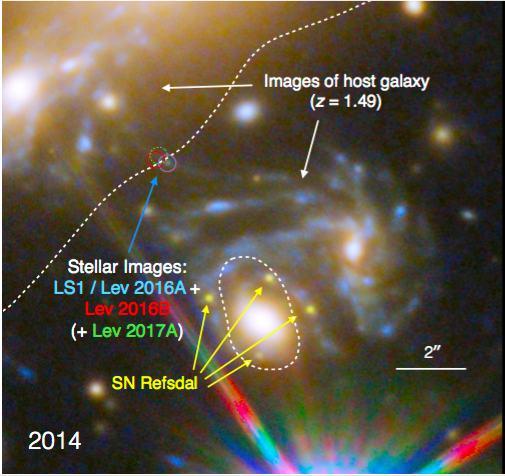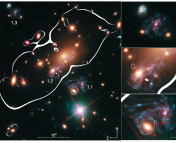Title: An individual star at redshift 1.5 extremely magnified by a galaxy-cluster lens
Authors: P. L. Kelly, J. M . Diego, S. Rodney et al.
First Author’s Institution: University of California, Berkeley, USA
Status: Submitted to Nature, closed access (with an open arXiv version in the link above)
To our readers in the US: a Happy 4th to you all!
I write this astrobite in my living room, assisted heavily by the lenses in my spectacles. It’s quite a marvelous thing – a pair of glasses. For the last decade or so, a pair of glasses have been necessary for me to marvel at the wonders of the world (and universe, now that studying astrophysics allows me to do that at leisure). Then, imagine my surprise when I came across the cosmic equivalent of my glasses and what a marvel they are! Gravitational lenses are some of the most massive structures in the universe, teaching us about the most distant and the most massive objects in the cosmos.
Gravitational lensing, as you may know, is a phenomenon predicted by Albert Einstein’s theory of General Relativity, where a massive object creates a gravitational potential well in the space it occupies. Every particle that passes through this potential well will follow a distorted path, since this potential well is essentially modifying the path available to particles itself. This ‘distortion’ also applies to photons. Hence, even light coming from background objects – like a star or a galaxy – gets distorted (or bent) on its way to us, if it encounters a ‘gravitational lens’ in its way. The effect was first detected by Sir Arthur Eddington in 1919 via observations of the same patch of sky during the night as well as during the day behind the sun – the idea was to check if the sun bent the light coming from stars behind it, by observing the patch of sky around the sun during a solar eclipse. The slight distortions – just like a regular magnifying glass or a pair of myopia-correcting glasses would cause – were found, and gravitational lensing was first observed! Since then, we have discovered multiple gigantic structures that act like lenses. Since this effect is based on an object creating distortions in space around them proportional to the mass they contain, the more massive the object, the greater the distorting effect. Hence, most lenses that we have studied well so far are galaxies, or even galaxy clusters which are the most massive collapsed objects in the universe. For more details, check out this video (Credits: ESO).
It is important to note that since a galaxy cluster can act as a gravitational lens, just like a magnifying glass it also has the capacity to ‘magnify’ background objects. Imagine a faint galaxy that we are not able to detect with regular telescopes. Now imagine the same galaxy when it happens to lie in the line of sight of a galaxy cluster. Based on its location and distance from the ‘lens’, a faint background galaxy can get magnified by several times, allowing its minimal flux to reach us at last. It is common for astrophysicists in this field to study large objects like faint blue galaxies at redshifts of 2-3 that get magnified by nearby galaxy clusters, which would not have been possible otherwise. This advancing field is only getting better with improved understanding of galaxy clusters as lenses – the calculations of their masses, and how this mass may be distributed throughout the cluster. Today’s study has gone one step further, into uncharted territory. Today’s study has observed a gravitationally lensed star!

Fig 2. Image of the initial SN Refsdal observations via the Hubble Space Telescope, as well as the newly discovered magnified star LS1.
From Hubble observations of a multiple-imaged supernova via gravitational lensing (see this astrobite for more details on Supernova Refsdal), Kelly et al. were successful in observing another extremely fascinating object too – a blue unresolved source of light, whose flux kept fluctuating. By taking spectra of that object, they concluded that it was a B-type star whose light was magnified approximately 2000 times on its way to us! In comparison, a typical galaxy is expected to be magnified by ~50 times. What makes this object undoubtedly a star are specific features seen in the spectra – namely the huge drop in flux around a rest-frame wavelength of ~3650 Angstroms called the Balmer break. Moreover, since the huge drop in flux is actually seen at a much higher wavelength, that allows for the calculation of the ‘redshift‘, or distance of the object. It turns out that this star, called LS1, is at a redshift of ~1.5, the farthest star ever discovered. For context, 99% of the stars you see in the night sky, are within the Milky Way. The farthest star we have discovered until now, is in a nearby galaxy few hundred thousand light years away. The light travel distance from LS1, on the other hand, is 9 billion light years !

Fig 3. The complete Spectral Energy Distribution (or a Flux map) of the observed star LS1. You can see that different models of stars with different temperatures and properties have been fit to the observations, in order to ascertain the nature of the faint blue star. The ‘Balmer break’ can be seen at ~9000A instead of a rest-frame wavelength of ~3650A, corresponding to a redshift of ~1.5.
Other properties of the star have also been observed – its temperature (~11000 K), its transverse velocity or motion in the sky (~1000 km/s) and the reason why this star magnified to the extent it did. In construction of mass models of galaxies (or clusters) that could cause gravitational lensing, there are certain surfaces around the lens that are called ‘caustics’. These surfaces correspond to a ‘mathematically infinite’ magnification in ideal lens models, and if an object is present on these unique surfaces, even a very faint object can pop out in lens observations! LS1 is no different – the models built in this paper suggest exactly that. This study also calculates the probability of a star to lie on a caustic, as well as the probability of such a massive hot star in the background existing at that distance. It is needless to say that observing such a distant star can tell us volumes about the nature of stellar population at high redshifts, as wells as test gravitational lens models to their extremes!
Keep an eye out for more on this in the near future. After all, it’s the farthest star ever seen by a human, guys!




My knowledge base must be missing a key concept. How can a star be 36 billion light years away when the universe is estimated to be only about 13.8 billion years old? Wouldn’t the furthest objects be about 13.8 billion light years away?
Have a look at veritasium’s “misconceptions about the universe” on youtube, he explains it better than I can!
“LS1 … is 36 billion light years away”
That seems too far away for its light to have arrived. Missing a decimal place?